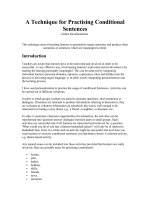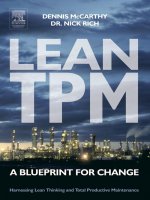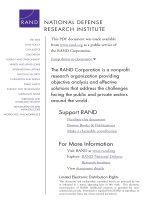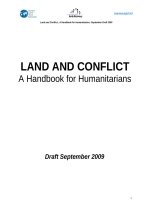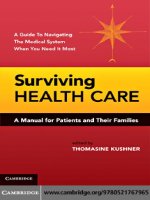2015 critical care MCQ a companion for intensive care exams
Bạn đang xem bản rút gọn của tài liệu. Xem và tải ngay bản đầy đủ của tài liệu tại đây (6.31 MB, 514 trang )
Critical care MCQs final cover.qxd
10/12/2014
17:38
Page 1
companion for anyone sitting exams in intensive care, as a training resource or just
wanting to improve their knowledge in this constantly developing area of medical
practice.
Written by critical care doctors with experience of UK and European examination
formats, this book leads the reader through 450 true/false questions with
referenced explanations, covering core syllabus topics and key influential papers to
date. A detailed list of further resources and recommendations relevant to critical
care revision is also provided to enable readers to further their knowledge and
understanding.
This book will prove invaluable for preparation and success in upcoming intensive
Critical Care MCQs — A Companion for Intensive Care Exams
Critical Care MCQs — A Companion for Intensive Care Exams is the perfect
Critical Care MCQs
A Companion for Intensive Care Exams
care exams for both candidates and trainers. This book would be useful for not only
candidates sitting the UK Fellowship of the Faculty of Intensive Care Medicine
(FFICM) and European Diploma in Intensive Care (EDIC) exams, but also the Indian
Diploma in Critical Care Medicine (IDCCM), the Diploma of the Irish Board of
Intensive Care Medicine (DIBICM), the Australian and New Zealand Fellowship of
the College of Intensive Care Medicine (CICM), the American Board and any other
examinations related to intensive care.
ISBN 978-1-903378-99-1
9 781903 378991
tf m
Steven Lobaz, Mika Hamilton,
Alastair Glossop, Ajay Raithatha
new-Prelims Critical Care MCQs_Prelims Critical Care MCQs.qxd 23/01/15 7:44 PM Page i
Critical Care MCQs
A Companion for Intensive Care Exams
Dr Steven Lobaz MBBS BMedSci FRCA FFICM
Consultant in Anaesthesia and Intensive Care Medicine
Barnsley Hospital NHS Foundation Trust, Barnsley, UK
Dr Mika Hamilton MBChB FRCA FFICM
Speciality Registrar (ST7) Anaesthesia and Intensive Care Medicine
The James Cook University Hospital, Middlesbrough, UK
Dr Alastair J Glossop BMedSci BMBS MRCP FRCA DICM FFICM
Consultant in Anaesthesia and Intensive Care Medicine
Sheffield Teaching Hospitals NHS Foundation Trust, Sheffield, UK
Dr Ajay Raithatha MBChB MRCP FRCA FFICM EDIC
Consultant in Anaesthesia and Intensive Care Medicine
Sheffield Teaching Hospitals NHS Foundation Trust, Sheffield, UK
i
new-Prelims Critical Care MCQs_Prelims Critical Care MCQs.qxd 23/01/15 7:44 PM Page ii
Critical Care MCQs — A Companion for Intensive Care Exams
tfm Publishing Limited, Castle Hill Barns, Harley, Shrewsbury, SY5 6LX, UK
Tel: +44 (0)1952 510061; Fax: +44 (0)1952 510192
E-mail:
Web site: www.tfmpublishing.com
Editing, design & typesetting: Nikki Bramhill BSc Hons Dip Law
First edition: © 2015
Front cover images: © 2015 istockphoto;
Paperback
ISBN: 978-1-903378-99-1
E-book editions:
2015
ePub
ISBN: 978-1-910079-15-7
Mobi
ISBN: 978-1-910079-16-4
Web pdf
ISBN: 978-1-910079-17-1
The entire contents of Critical Care MCQs — A Companion for Intensive
Care Exams is copyright tfm Publishing Ltd. Apart from any fair dealing for
the purposes of research or private study, or criticism or review, as permitted
under the Copyright, Designs and Patents Act 1988, this publication may
not be reproduced, stored in a retrieval system or transmitted in any form or
by any means, electronic, digital, mechanical, photocopying, recording or
otherwise, without the prior written permission of the publisher.
Neither the authors nor the publisher can accept responsibility for any injury
or damage to persons or property occasioned through the implementation
of any ideas or use of any product described herein. Neither can they accept
any responsibility for errors, omissions or misrepresentations, howsoever
caused.
Whilst every care is taken by the authors and the publisher to ensure that all
information and data in this book are as accurate as possible at the time of
going to press, it is recommended that readers seek independent
verification of advice on drug or other product usage, surgical techniques
and clinical processes prior to their use.
The authors and publisher gratefully acknowledge the permission granted
to reproduce the copyright material where applicable in this book. Every
effort has been made to trace copyright holders and to obtain their
permission for the use of copyright material. The publisher apologizes for
any errors or omissions and would be grateful if notified of any corrections
that should be incorporated in future reprints or editions of this book.
ii
Printed by Gutenberg Press Ltd., Gudja Road, Tarxien, PLA 19, Malta
new-Prelims Critical Care MCQs_Prelims Critical Care MCQs.qxd 23/01/15 7:44 PM Page iii
l
Contents
Page
Preface
iv
Acknowledgements
v
Introduction
vi
Dedication
vii
Paper 1: Questions
Paper 1: Answers
1
31
Paper 2: Questions
Paper 2: Answers
99
127
Paper 3: Questions
Paper 3: Answers
197
225
Paper 4: Questions
Paper 4: Answers
293
321
Paper 5: Questions
Paper 5: Answers
385
415
Intensive Care Resources
487
Index
489
iii
new-Prelims Critical Care MCQs_Prelims Critical Care MCQs.qxd 23/01/15 7:44 PM Page iv
l
Preface
To many candidates the prospect of sitting an intensive care medicine
exam can be daunting. The specialty is vast in its scope, one which is
developing and evolving rapidly. However, with hard work and dedication,
success can be achieved by the majority of candidates. We believe that
this book, written by doctors who have collectively passed the UK FFICM
and European Diploma examinations, is a perfect companion and guide to
success in critical care exams. It encompasses both core syllabus topics
and recent influential papers, and is an invaluable resource for preparation
and success.
Good luck!
Dr Steven Lobaz MBBS BMedSci FRCA FFICM
Dr Mika Hamilton MBChB FRCA FFICM
Dr Alastair J Glossop BMedSci BMBS MRCP FRCA DICM FFICM
Dr Ajay Raithatha MBChB MRCP FRCA FFICM EDIC
January 2015
iv
new-Prelims Critical Care MCQs_Prelims Critical Care MCQs.qxd 23/01/15 7:44 PM Page v
l
Acknowledgements
The authors would like to thank Dr Helen Ellis for her time and efforts in
testing and critiquing the papers in this book. Her comments have proved
invaluable during the final editorial process and we are very grateful for
this.
We would also like to thank Nikki Bramhill at tfm publishing for helping
to make this book a reality.
v
new-Prelims Critical Care MCQs_Prelims Critical Care MCQs.qxd 23/01/15 7:44 PM Page vi
l
Introduction
Through five complete examination papers, each compromising 90
questions of 5 true or false stems, this book takes the reader through the
core areas of intensive care medicine. Each paper is designed to cover a
wide range of syllabus topics relevant to several major examination formats
including: the UK Fellowship of the Faculty of Intensive Care Medicine
(FFICM), the European Diploma in Intensive Care (EDIC), the Indian
Diploma in Critical Care Medicine (IDCCM), the Diploma of the Irish
Board of Intensive Care Medicine (DIBICM), the Australian and New
Zealand Fellowship of the College of Intensive Care Medicine (CICM),
and American board exams.
The questions are set at a level designed to test the knowledge of
higher trainees in the specialty. A score of 72-74% (with a positive
marking scoring system) is deemed the pass mark for each paper, which
is comparable to the pass mark for the MCQ section of the FFICM
examination.
Following each 90-question paper, an answer overview can be found.
Each answer has the question title, summary of the true stems and a brief
explanation and discussion attached. Relevant and up-to-date references
are listed at the end of each answer.
A detailed list of further resources and recommendations relevant to
critical care is provided at the end of the book, enabling readers to further
their knowledge base and level of understanding.
vi
Success in MCQ examinations requires a strong knowledge base but
also good examination technique. We hope that this book will provide
prospective candidates with the question practice and background
reading required to be successful. We wish you the best of luck.
new-Prelims Critical Care MCQs_Prelims Critical Care MCQs.qxd 23/01/15 7:44 PM Page vii
l
Dedication
I wish to dedicate this book to all the staff at the Royal Victoria Infirmary
and Freeman Hospital, Newcastle-upon-Tyne, UK, in particular, Dr Kirk, Mr
Hassan, Dr Smith and all staff involved in paediatric cardiology, surgery,
anaesthesia and critical care. Without their efforts and expertise I would
not have been given the most precious gift — the chance to be a father to
my daughter Eva. Words cannot express my eternal gratitude. Thank you.
Dr Steven Lobaz MBBS BMedSci FRCA FFICM
vii
new-Prelims Critical Care MCQs_Prelims Critical Care MCQs.qxd 23/01/15 7:44 PM Page viii
Critical Care MCQs — A Companion for Intensive Care Exams
“Believe in yourself! Have faith in your abilities!
Without a humble but reasonable confidence in your own
powers you cannot be successful or happy.” Norman Vincent Peale
viii
new-Paper 1 questions_Paper 1 questions.qxd 24/01/15 10:57 AM Page 1
“Fortune favours the prepared mind.” Louis Pasteur
1
MCQ Paper 1: Questions
l
a
b
c
d
e
l
a
b
c
d
e
Question 1: In relation to the drug sugammadex:
It is recommended for immediate reversal of vecuronium.
It can effectively reverse cisatracurium.
16mg/kg is recommended intravenously for the immediate reversal
of rocuronium.
It is an α-cyclodextrin that encapsulates aminosteroid
neuromuscular blocking agents.
Sugammadex may be effective in treating rocuronium-induced
anaphylaxis.
Question 2: For patients with coronary artery stents
undergoing non-cardiac surgery:
Non-urgent surgery should be delayed in the immediate post-stent
period.
Drug-eluting stents (DES) have reduced restenosis rates at 1 year,
when compared to bare metal stents (BMS).
Bare metal stents (BMS) require 4-6 months of clopidogrel therapy.
Dual antiplatelet therapy is associated with an increased perioperative mortality.
Biocompatible stents (e.g. Genous™ R-stent) require peri-operative
bridging therapy.
1
new-Paper 1 questions_Paper 1 questions.qxd 24/01/15 10:57 AM Page 2
Critical Care MCQs — A Companion for Intensive Care Exams
l
a
b
c
d
e
l
a
b
c
d
e
l
a
b
c
d
e
l
a
b
2
Question 3: Regarding The Royal College of Anaesthetists’
4th National Audit Project (NAP4):
Airway complications in intensive care resulted in death or disability
in less than 20% of cases.
End-tidal CO2 monitoring (capnography) is not always necessary for
intubation.
A difficult airway trolley is recommended for all intensive care units.
Regular audit of airway complications should occur.
Transfer of an intubated patient is deemed low risk for airway
complications.
Question 4: In relation to a potential ‘can’t intubate, can’t
ventilate (CICV) scenario’ in anaesthesia practice:
It is estimated to occur in 0.01 to 2.0 per 100,000 cases.
Jet ventilation is required for cricothyroidotomy with a cannula of
>4mm diameter.
Over 90% of CICV situations are preventable.
Fixation error may lead to loss of situational awareness and poor
decision making.
Cricothyroidotomy skills are retained for only a short period.
Question 5: In quinine sulphate overdose:
The QTc interval shortens.
Temporary deafness can occur.
Amiodarone is the anti-arrhythmic of choice for ventricular
tachycardia (VT) with a pulse.
Quinine induces insulin release.
Continuous veno-venous haemofiltration (CVVH) will remove quinine.
Question
6:
The
pre-test
thrombocytopenia (HIT) score:
Has four categories.
Has a maximum score of 4.
heparin-induced
new-Paper 1 questions_Paper 1 questions.qxd 24/01/15 10:57 AM Page 3
MCQ Paper 1: Questions
c
d
e
l
a
b
c
d
e
l
a
b
c
d
e
l
a
b
c
d
e
A score of 2 is given for a >50% fall in platelets.
A total score of 3 indicates a 20% pre-test probability of HIT.
A platelet fall in <4 days since heparin administration and no recent
prior heparin exposure is given a zero score.
Question 7: Concerning bronchoscopy in critical care:
It is an essential diagnostic and therapeutic procedure.
One should wear full protective clothing during bronchoscopy.
Following bronchoscopy, the suction port should be immediately
brushed through and the bronchoscope sent for decontamination.
It should be possible to visualise the first 2-7 divisions of each lobar
bronchus.
During bronchial-alveolar lavage, 20-60ml 0.9% saline should be
instilled prior to suctioning and specimen trap.
Question 8: In relation to the cerebral arterial circulation:
The basilar artery originates at the junction of the left and right
vertebral arteries.
The basilar artery travels posterior to the brainstem.
The middle cerebral arteries supply the lateral aspect of the brain
including the frontal, parietal, occipital, temporal and insular lobes.
70% of the arterial blood supply to the brain arises from the internal
carotid arteries.
The posterior inferior cerebellar artery (PICA) is the largest of the
cerebellar arteries arising from the vertebral artery.
Question 9: In acute graft versus host disease (AGVHD):
The skin, liver and gut are commonly involved.
Donor B lymphocytes attack host tissues.
Infliximab or mycophenolate mofetil are given as first-line treatment.
Calcineurin inhibitors are commonly used in the prophylaxis of
AGVHD.
Transfusion-associated AGVHD has a mortality of less than 45%.
3
new-Paper 1 questions_Paper 1 questions.qxd 24/01/15 10:57 AM Page 4
Critical Care MCQs — A Companion for Intensive Care Exams
l
a
b
c
d
e
l
a
b
c
d
e
l
a
b
c
d
e
4
Question 10: Red cell transfusion and critical care:
The World Health Organisation (WHO) defines anaemia in men and
women as a haemoglobin (Hb) <110g/L and <100g/L, respectively.
A transfusion trigger of 80g/L or below should be the default for
critically ill patients.
The majority of blood transfusions given on intensive care are to
treat major haemorrhage.
Transfusion to greater than Hb >80g/L assists weaning from
mechanical ventilation.
A target of 100g/L should be maintained in patients with stable
angina.
Question
11:
Concerning
thrombocytopenia (Type II HIT):
heparin-induced
The platelet count typically falls by 30-50% within 5-10 days after
initiation of heparin.
The incidence is 10x higher with unfractionated versus lowmolecular-weight heparin (LMWH).
It is more common in male patients.
IgM antibodies to the heparin-PF4 antigen occurs on the surface of
platelets.
Danaparoid has been used successfully to treat HIT-induced
thrombosis.
Question 12: The larynx:
In adults extends from C3 to C6 in the midline.
The external branch of the superior laryngeal nerve innervates the
cricothyroid muscle.
The superior laryngeal nerve is a branch of the vagus nerve.
Damage to the external branch of the superior laryngeal nerve
results in a cadaveric vocal cord position.
Tracheostomy is performed through the cricothyroid membrane.
new-Paper 1 questions_Paper 1 questions.qxd 24/01/15 10:57 AM Page 5
MCQ Paper 1: Questions
l
a
b
c
d
e
l
a
b
c
d
e
l
a
b
c
d
e
Question 13: The following statements are true about
electrocardiogram (ECG) monitoring:
Standard calibration is 25mm/s and 1mV/cm.
Lead II is best for detecting arrhythmias.
CM5 lead is superior for detecting coronary ischaemia versus an
individual limb lead.
A five-lead ECG has 60% sensitivity for detecting inferior or anterior
ischaemia.
Normal axis is between 30 to 90°.
Question 14: In relation to acute aortic dissection:
The condition often presents with abrupt-onset sharp chest or back
pain.
It is more common in females with a peak incidence between 50-70
years of age.
The European Society of Cardiology classifies the condition into
Type A and Type B.
Adequate β-blockade should be established before initiation of
vasodilator therapy in the medical management of acute aortic
dissection.
Type A aortic dissection is managed medically.
Question 15: Regarding defibrillation:
Early defibrillation is paramount if indicated during cardiac arrest.
Transthoracic impedance is approximately 100 Ohms in adults.
Anteroposterior electrode placement is less effective than the
sternal-apical position.
Biphasic defibrillators have a first shock efficacy of >86% for long
duration ventricular fibrillation.
Biphasic defibrillators offer a survival advantage over monophasic
devices.
5
new-Paper 1 questions_Paper 1 questions.qxd 24/01/15 10:57 AM Page 6
Critical Care MCQs — A Companion for Intensive Care Exams
l
a
b
c
d
e
l
a
b
c
d
e
l
a
b
c
d
e
l
a
b
c
d
6
Question 16: Considering intra-aortic balloon pump (IABP)
use:
Myocardial oxygen supply is increased.
Carbon dioxide is used for balloon inflation.
Balloon inflation occurs in early systole.
Deflation occurs on the electrocardiogram R-wave peak.
The diameter of the balloon should not exceed 80-90% of the
patient’s descending aortic diameter.
Question 17: Indications for cardiac pacing include:
Permanent atrial fibrillation (AF) with atrioventricular (AV) block.
Symptomatic Mobitz Type I second-degree heart block.
Third-degree heart block.
Torsades de pointes.
Asystolic episodes.
Question 18: Considering the critical care management of
acute liver failure (ALF):
N-acetylcysteine (NAC) is beneficial in non-paracetamol-induced
ALF.
Intracranial pressure monitoring is advised in low-grade
encephalopathy.
ALF is characterised by low cardiac output and often requires
vasopressor support.
High positive end-expiratory pressures (PEEP) may exacerbate
hepatic congestion.
Hepatocyte necrosis causes hyperglycaemia.
Question 19: Variceal bleeding:
Immediate mortality is estimated to be 2%.
Portal hypotension is the most common cause.
Terlipressin may be beneficial in reducing bleeding.
Broad-spectrum antibiotics should be given acutely.
new-Paper 1 questions_Paper 1 questions.qxd 24/01/15 10:57 AM Page 7
MCQ Paper 1: Questions
e
l
a
b
c
d
e
l
a
b
c
d
e
l
a
b
c
d
e
A transjugular intrahepatic portosystemic shunt (TIPS) and liver
transplantation may be considered in severe variceal bleeding.
Question 20: Regarding the Sengstaken-Blakemore tube
(SBT):
80% of patients will rebleed once the balloon is deflated.
It is effective at controlling torrential bleeding from oesophagogastric varices.
It has three lumens.
Insertion to the 55cm mark at the incisors indicates that the gastric
balloon position is below the gastro-oesophageal junction.
The oesophageal balloon must be deflated every 6 hours.
Question 21: Regarding surgical resection of the
oesophagus:
A lumbar epidural is likely to be beneficial.
A fibre-optic scope should be available to confirm correct doublelumen tube (DLT) placement.
Respiratory morbidity is high postoperatively.
Non-invasive ventilation in the early postoperative period is
absolutely contraindicated.
Acute onset of fast atrial fibrillation at 3-7 days postoperatively may
herald the development of an anastomotic leak.
Question 22: In relation to the classification of acute liver
failure (ALF):
The O’Grady system classifies ALF into hyperacute, acute and
subacute categories.
Is defined as ‘acute’ according to the O’Grady system, when
jaundice to encephalopathy occurs in less than 1 month.
‘Hyperacute’ is when the onset of encephalopathy occurs less than
1 week after jaundice.
The Bernuau system classifies ALF as acute and subacute.
The Japanese system classifies ALF into fulminant and subfulminant
categories.
7
new-Paper 1 questions_Paper 1 questions.qxd 24/01/15 10:57 AM Page 8
Critical Care MCQs — A Companion for Intensive Care Exams
l
a
b
c
d
e
l
a
b
c
d
e
l
a
b
c
d
e
8
Question 23: In relation to ethylene glycol (EG) poisoning:
It may present with an acute ascending motor and sensory
neuropathy.
A normal anion gap acidosis is usually seen.
Alcohol dehydrogenase catabolises the metabolism of EG into
metabolites including oxalate and glycolic acid.
Haemodialysis is not effective.
Fomepizole is a potent inducer of alcohol dehydrogenase and an
effective treatment.
Question 24: The following statements concerning
spontaneous bacterial peritonitis (SBP) in chronic liver
disease are true:
The probability of survival at 2 years following one episode of SBP
in cirrhosis is approximately 50%.
A neutrophil count of >150 neutrophils/mm3 in ascites is diagnostic
for SBP.
The administration of albumin may decrease the development of
hepatorenal syndrome.
Ascitic culture is negative in up to 40% of cultures taken from
patients with suspected SBP.
Routine antibiotic prophylaxis is not recommended in patients with
cirrhosis and ascites, who have had one previous episode of SBP.
Question 25: Regarding alcoholic liver disease (ALD):
30% of cirrhotic patients develop hepatorenal syndrome (HRS)
within 1 year of diagnosis.
One UK unit of alcohol contains 20-24g ethanol.
Patients may present with Wernicke’s encephalopathy.
Ethanol metabolism causes accumulation of lipid in liver cells.
Infliximab (TNF-α inhibitor) is useful in preventing hepatorenal
syndrome in severe ALD.
new-Paper 1 questions_Paper 1 questions.qxd 24/01/15 10:57 AM Page 9
MCQ Paper 1: Questions
l
a
b
c
d
e
l
a
b
c
d
e
l
a
b
c
d
e
Question 26: Considering oxygen delivery (DO2) in adults:
DO2 below 300ml/minute results in shock.
Clinical signs such as heart rate, blood pressure and urine output
are useful signs of oxygen delivery in young adult patients.
At rest, the metabolic demands of an average person can be met by
dissolved O2 alone when breathing FiO2 1.0 at 3 atmospheres.
DO2 is reliant on conduction, convection and diffusion.
Achieving supranormal values of DO2 is beneficial in sepsis.
Question 27: Oesophageal Doppler:
Utilises the Doppler shift to measure blood velocity.
Velocity of blood (m/s) in the descending aorta can be calculated
provided the aortic cross-sectional area is known.
It is assumed 70% of cardiac output is distributed caudally to the
descending aorta.
Doppler probes must be removed after 1 week.
Is accurate when used with a working epidural.
Question 28: In relation to the PiCCO cardiac monitor, the
following statements are true:
A central line is needed only.
Thermodilution is used to calibrate the pulse pressure algorithm.
Mean transit time (MTT) represents the time taken for all the thermal
tracer to pass through the venous circulation, heart and lungs to the
arterial circulation.
Pulmonary thermal volume (PTV) can be calculated from the
downslope time (DST).
Global end-diastolic volume (GEDV) = (mean transit time x cardiac
output) - pulmonary thermal volume.
9
new-Paper 1 questions_Paper 1 questions.qxd 24/01/15 10:57 AM Page 10
Critical Care MCQs — A Companion for Intensive Care Exams
l
a
b
c
d
e
l
a
b
c
d
e
l
a
b
c
d
e
10
Question 29: Derived variables from a pulmonary artery
catheter:
A cardiac index of 2.1L/min/m2 is normal.
Normal systemic vascular resistance index (SVRI) is 800-1200
dynes.sec/cm5/m2.
Pulmonary vascular resistance is normally <250 dynes.sec/cm5.
Coronary artery perfusion pressure = systolic blood pressure pulmonary artery occlusion pressure.
Stroke volume index (SVI) is normally 35-70ml/m2/beat.
Question 30: Concerning liver transplantation for acute
liver failure (ALF):
Most deaths after transplantation occur during the first 3 months
postoperatively.
Risk of death is higher in recipients who received a graft from an
identical ABO donor.
20% of liver transplants are performed in ALF patients.
Early postoperative impaired graft function is poorly tolerated.
After the first year following transplants, ALF patients have a better
long-term survival than chronic liver failure patients.
Question 31: The lungs and bronchial tree:
The left lung has two fissures.
After 2.5cm the left main bronchus gives off the left upper lobe
bronchus.
The left lower lobe bronchus is made up of five branches.
Lateral and posterior branches make up the right middle lobe
bronchus.
The left main bronchus is shorter and wider than the right main
bronchus.
new-Paper 1 questions_Paper 1 questions.qxd 24/01/15 10:57 AM Page 11
MCQ Paper 1: Questions
l
a
b
c
d
e
l
a
b
c
d
e
l
a
b
c
d
e
Question 32: In relation to paracetamol (acetaminophen)
overdose:
N-acetyl-p-benzo-quinone-imine (NAPQI) is produced by
glucuronidation of paracetamol in the liver.
Plasma paracetamol levels on or above 100mg/L at 4 hours and
15mg/L at 15 hours after ingestion warrant treatment.
The toxicity nomogram is reliable in cases of staggered overdose.
Initial loading of N-acetylcysteine (NAC) 150mg/kg over 1 hour is
recommended.
Hypersensitivity is a contraindication to NAC.
Question 33: Concerning recreational drug toxicity:
Dantrolene may be used for acute hyperpyrexia caused by ecstasy
(MDMA).
Cocaine abuse should be considered in any young person
presenting with acute chest pain.
Chlordiazepoxide may be effective for acute alcohol withdrawal.
Dilated pupils, hypotonia and hyporeflexia may occur in children
following accidental ingestion of cannabis.
Mephedrone toxicity is associated with peripheral vasodilatation.
Question 34: In relation to the Glasgow Coma Scale (GCS):
It is incorporated in the Acute Physiology And Chronic Health
Evaluation II (APACHE II) scoring system.
The FOUR score is inferior to the GCS as it cannot be carried out
when the patient is intubated and ventilated.
A score of 8 or less is considered coma where airway reflexes may
be inadequate.
May have prognostic significance after traumatic brain injury.
A patient who is opening eyes to pain, mumbles sounds and
withdraws to a painful stimulus scores 9/15.
11
new-Paper 1 questions_Paper 1 questions.qxd 24/01/15 10:57 AM Page 12
Critical Care MCQs — A Companion for Intensive Care Exams
l
a
b
c
d
e
l
a
b
c
d
e
l
a
b
c
d
e
12
Question 35: Concerning cervical cord injury and critical
care:
Fibre-optic intubation in patients with cervical cord injury has been
proven to be a superior and safer technique, compared to
orotracheal intubation with manual in-line stabilisation.
Maintaining patients in the semi-upright position optimises breathing.
The risk of deep vein thrombosis is increased three-fold.
In autonomic dysreflexia, hypertension typically occurs above the
level of the lesion.
In non-penetrating spinal cord injury, administration of high-dose
methylprednisolone within 8 hours of injury is a recommended
treatment.
Question 36: Lumbar drain management:
A lumbar drain is an epidural catheter inserted into the subarachnoid
space.
It may improve spinal cord perfusion following suprarenal aortic
aneurysm repair.
The zero level should be at the level of the atria.
Drain height, maximum permitted drainage per hour and duration of
drainage should be prescribed.
Excess cerebrospinal fluid (CSF) drainage is common and is
associated with few minor complications.
Question 37: In relation to nerve conduction study
patterns:
Motor conduction only is reduced in critical care polyneuropathy.
In motor neuron disease sensory nerve conduction is reduced.
Motor nerve conduction is reduced but increases with further
repetition in myasthenia gravis.
Motor nerve conduction is slowed or blocked in Guillain-Barré
syndrome.
Electromyography (EMG) shows fibrillations in motor neuron
disease.
new-Paper 1 questions_Paper 1 questions.qxd 24/01/15 10:57 AM Page 13
MCQ Paper 1: Questions
l
a
b
c
d
e
l
a
b
c
d
e
l
a
b
c
d
e
Question 38: In patients with brain herniation due to
raised intracranial pressure (ICP):
Tentorial/uncal herniation causes pupillary dilatation and ptosis.
Tonsillar herniation occurs when the cerebellum herniates into the
posterior fossa.
Compression of the midbrain may cause Cushing’s syndrome.
Persistent ICP of <20mmHg is associated with a better outcome in
traumatic brain injury.
Critically high ICP commonly causes hypotension and tachycardia.
Question 39: Concerning intracranial pressure (ICP)
waveforms the following statements are true:
The normal ICP trace looks similar to an arterial trace in appearance.
P1 is caused by an arterial pressure percussion wave being
transmitted from the choroid plexus to the ventricle.
P2 is the dichrotic wave due to aortic valve closure.
With high ICP, brain compliance reduces and the P1 component
exceeds P2 with the wave becoming broader.
Plateau waves (Lundberg A waves) are always pathological.
Question 40: Pre-operative β-blockade use for noncardiac surgery:
Should be started in patients with pre-existing ischaemic heart
disease.
Is associated with increased mortality.
Is associated with a decrease in non-fatal myocardial infarction.
Is associated with increased stroke events.
Is based on robust clinical trial data.
13
new-Paper 1 questions_Paper 1 questions.qxd 24/01/15 10:57 AM Page 14
Critical Care MCQs — A Companion for Intensive Care Exams
l
a
b
c
d
e
l
a
b
c
d
e
l
a
b
c
d
e
14
Question 41: Mannitol 20%:
A 500ml bag contains 100g of mannitol.
Is alkalotic.
Mannitol solutions may crystallise at room temperature and should
be discarded.
Exerts its effects by increasing diuresis.
0.25-1.0mg/kg should be given intravenously for significantly raised
intracranial pressure.
Question 42: Pain management on critical care:
It is estimated that 45% of critical care patients remember
experiencing pain during their stay.
The Behaviourial Pain Scale (BPS) is composed of four
observational areas and is scored from 0 to a maximum of 8.
The Critical-care Pain Observation Tool (CPOT) is not suitable for
intubated patients.
Uncontrolled pain has been linked to adverse patient consequences.
For non-neuropathic pain, intravenous opioids are considered for
first-line management.
Question 43: In relation to prerequisites for brainstem
death testing:
The aetiology of irreversible brain damage does not need to be
known.
Testing should not be undertaken if thiopentone assay results are
>5mg/L.
Core temperature should be greater than 35°C at the time of testing.
Sodium levels should be between 115 to 160mmol/L.
Phosphate should be greater than 0.5 but less than 3.0mmol/L.
new-Paper 1 questions_Paper 1 questions.qxd 24/01/15 10:57 AM Page 15
MCQ Paper 1: Questions
l
a
b
c
d
e
l
a
b
c
d
e
l
a
b
c
d
e
Question 44: Echocardiography and critical care:
Ultrasound is sound with a frequency above 20MHz.
The speed of sound in tissue is 1570m/s.
Better resolution is observed with higher frequencies.
Severe aortic stenosis is classically defined as a valve area of 0.60.8cm2.
A false-positive examination for infective endocarditis may occur in
systemic lupus erythematosus (SLE).
Question 45: When considering transfer of critically ill
patients:
A standard ambulance trolley is preferred for patient transfers.
Neurosurgical transfers are time-critical and need to be expedited
regardless of stability.
Transfers for non-clinical reasons should only take place in
exceptional circumstances and ideally only in daylight hours.
Departure checklists are a crucial aid and may prevent disaster.
Intra-hospital transfer does not increase complications in ventilated
critically ill patients.
Question 46: In paediatric meningococcal disease:
Group B meningococcus is the most common cause in patients
aged 3 months or older in the UK.
Classical signs are often absent in infants and may occur without a
non-blanching rash.
Benzylpenicillin (intravenous or intramuscular) should be given prehospital without delay.
Intravenous ceftriaxone should be given immediately if
meningococcal disease is suspected on arrival to hospital.
It is vital that lumbar puncture is performed without delay.
15
new-Paper 1 questions_Paper 1 questions.qxd 24/01/15 10:57 AM Page 16
Critical Care MCQs — A Companion for Intensive Care Exams
l
a
b
c
d
e
l
a
b
c
d
e
l
a
b
c
d
e
l
16
a
b
Question 47: Regarding paediatric airway emergencies:
Croup presents with high fever and dyspnoea.
Epiglottitis presents classically with drooling, dyspnoea, dysphagia
and dysphonia.
Sevoflurane and topical anaesthesia is the airway technique of
choice for removal of a foreign body with a Storz bronchoscope.
In the UK, the National Audit Project 4 (NAP4) showed that
cricothyroidotomy was used in most cases where a child could not
be intubated or ventilated.
A high-flow nasal cannula (HFNC) is well tolerated and beneficial in
young infants with acute viral bronchiolitis.
Question 48: The following statements are true about
human immunodeficiency virus (HIV) infection:
Fever is the most common presenting feature of seroconversion
illness.
HIV DNA levels in the plasma correlate with serum CD4 count, rate
of decline and progression to acquired immune deficiency syndrome
(AIDS).
AIDS is defined by a CD4 level <200 cells/µl.
HIV infection frequently occurs after needle stick injuries.
Median survival in patients with HIV in the UK is 15 years.
Question 49: Regarding anti-retroviral therapy (ART) in
human immunodeficiency virus (HIV):
Zidovudine (AZT) is a non-nucleoside reverse transcriptase inhibitor.
Fusion inhibitors block fusion of HIV with the cell membrane.
Lamivudine (3TC) can cause fatal lactic acidosis.
Initiating ART in the critical care unit is hazardous.
Nevirapine is currently effective against the HIV-2 subtype.
Question 50: Acute and chronic adverse effects of
glucocorticoids include:
Distal muscle weakness.
Hypoglycaemia.
